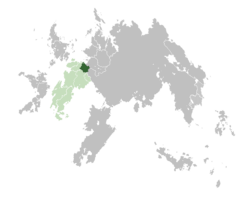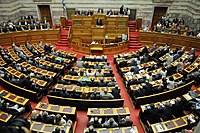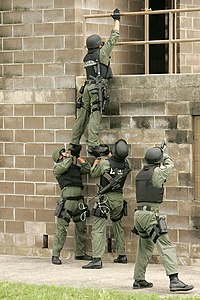Brilliania
This article is incomplete because it is pending further input from participants, or it is a work-in-progress by one author. Please comment on this article's talk page to share your input, comments and questions. Note: To contribute to this article, you may need to seek help from the author(s) of this page. |
Federal Republic of Brilliania Errepublika Federala Berilinakoren | |
|---|---|
|
Flag | |
| Motto: Mantendu egingo dugu We will maintain | |
| Anthem: Ereszerki (Hymn) | |
 Location of Brilliania (dark green) in Cardia (green) | |
| Capital | Szaranegertu |
| Largest | Martirien Herria |
| Official languages | Brillian, Iparinan |
| Demonym(s) | Brillian |
| Government | Federal presidential republic |
| Endrike Karagori | |
| Alcsai Vikuna | |
| Population | |
• 2017 census | 18,792,090 |
| GDP (nominal) | 2017 estimate |
• Total | $311,478,891,750 |
• Per capita | $16,575 |
| Gini (2016) | medium |
| HDI (2017) | very high |
| Currency | Brillian Florrin (EBF) |
| Date format | yyyy-mm-dd |
| Driving side | right |
| ISO 3166 code | EB |
| Internet TLD | .eb |
Brilliania (Brillian: Berilinako), officially the Federal Republic of Brilliania, (Brillian: Errepublika Federala Berilinakoren) is a sovereign state in northeastern Cardia, bordered by the XXX sea and the nations of Dulebia to the east and Finium to the south. Brilliania consists of 6 states, which each enjoy a certain degree of autonomy. It is a federal presidential republic with around 18,8 million inhabitants. Ethnic Brillian people, which speak the isolated Brillian language make up 79% of the population, with a significant minority of Iparinans from the southeastern region of Iparina.
Brilliania was ruled by a monarchy between xxx and 1933, starting when Prince Ganis unified several Brillian towns in the year xxx, and ending with the abdication of Prince Ilurdo in 1933. However, the Prince became mostly ceremonial in 1889, with the creation of the first parliament of Brilliania after the signing of the Palace Agreement. A limited form of male suffrage was employed, although the parliament was soon rife with corruption. Female suffrage did not exist prior to the Millenium Revolution in 2000.
Brilliania is a developed country with a high-income service-based economy. It ranks highly in the Human Development Index. Although recent governments have prioritized the increasement of social security programmes, most Brillian citizens in rural areas are poorer than average. Although the domestic economy of Brilliania is strong, foreign trade is low due to Brilliania's former status as a pariah state.
History
Prehistory
Kingdom (xxx - 14xx)
Era of Difficulty (14xx - 15xx)
United Republic of the Brillian Provinces (165x - 1843)
Princedom (1843 - 1890)
Crowned Republic (1890 - 1933)
In 1888, republican activist Artze Bidecurucio nailed a paper to the door of the Royal Palace, containing ten demands to the King. King Ilurdo initially refused to agree, but reluctantly signed the Agreement of the Palace in 1890. The elections in 1891 marked the start of Brillian democracy. Although the entire male populace was allowed to vote, peasants were often barred from voting due to being illiterate or residing in a constituency where the representative often bribed officers to disallow peasants. Elections were also not secret.
Republic under the Second Constitution (1933 - 1965)
Republic under the Third Constitution (1965 - 2002)
Millenium Revolution (2000 - 2002)
The Millenium Revolution was a series of widespread protests by organisations opposing the rule of ultra-conservative First Citizen Salbacaile Ecsebarrea. The main cause of the protests was the death of Marin Juhász, which was killed by a police officer in a frenzy during protests against the Ecsebarrea government. Initial demands made to the government included full universal suffrage, a total end to police violence, the release of imprisoned prisoenrs and the resignation of Salbacaile Ecsebarrea and the ministers associated with his government.
Republic under the Fourth Constitution (2002 - current)
Brilliania started its transition to full democracy in 2002, after the approval of the Fourth Constitution of the Republic by a constitutional referendum. The Fourth Constitution introduced points which were widespread in other nations but not yet implemented in Brilliania, including female suffrage, the right to divorce and the decriminalization of homosexual activities.
Geography
Climate
Environment
Politics and Government
The Republic of Brilliania is administered as a federal presidential republic governed by the laws defined in the Fourth Constitution of the Republic, which was signed in 2002. The parliament of Brilliania is the unicameral National Assembly. The highest role in Brillian politics is the Lehendahiritar, also known as the First Citizen, which is elected directly by the electorate using the two-round system. The current First Citizen is Endrike Karagori, representing the AKB. He was inaugurated on 1 February 2019, after being elected on 26 January 2019.
Parliament
The National Assembly is the unicameral parliament of Brilliania. It is responsible for creating law proposals, together with the First Citizen and the ministers. As the supreme lawmaking authority of the Republic, it is also responsible for the supply of confidence to ministers and for the debate on law proposals. Since the fall of the Young Democratic Alliance in 2000, Brilliania is a liberal democratic state, governed by the Fourth Constitution of the Republic. The Bacar gathers for five days in the week, with additional sessions possible if called by a minister or the First Citizen. Because of the party diversity and the election method, an absolute majority has not occurred since 2000. Therefore, the government is often composed of coalition governments with several parties. Since the start of democracy in Brilliania, the Bacar has usually been dominated by three ideological groupings; liberals, socialists and conservatives.
Since 2005, the parliamentary rules have included provisions for a weekly parliamentary question session for the First Citizen.
Parties
Brilliania has a multi-party system. The most recent legislative election occured on 1 September 2019.
Law and judicial system
The judicial system in Brilliania is based off civil law and religious law. There are three kinds of courts: district courts, regional high courts and the Supreme Court (Kuria). The Kuria is based in Saranegertu.
Law enforcement in Brilliania is operated by the Ercainca Rendőrség , which carries out all major police duties such as investigation, patrol activity, traffic policing and border control. The Ercainca/Rendőrség is led by the Federal Commissioner of Law Enforcement, supervized by the Interior Minister. It is divided into regional and city divisions. The elite force of the Ercainca/Rendőrség, the semi-militarized Jendarme, is used for riot control and critical incidents. Officially, the Jendarme is a wing of the Brillian Army.
Military
The Brillian army has suffered from lack of budget in recent years; affecting its purchase of materials and causing them to still use outdated equipment. The Army has 4 divisions; the Land Forces, Navy, Air Force and the Jendarme (the elite unit of the Ercainca/Rendőrség).
Foreign Relations
Economy
Energy
Industry
Infrastructure
Transport
Brilliania has a highly developed network of road, train, air and sea connections. Martirien Heria and Aingeruak (Angyalok) are major hubs for train travel. All trains are owned by the state-owned Trenfed (Trenbide Federala; Federal Rail) company, which is responsible for operation of train stations.
Brilliania has arond 3500 kilometres of highways (autobidea), mostly connecting between cities. There are also 5000 kilometres of provincial roads (autobidea estatuak).
Demographics
According to the most recent national census, a total of around 18.8 million people live in the Republic of Brilliania. Most citizens live in Kostegarba, Iparina and Ocaurte provinces. The largest city is Martirien Heria, which houses around 2 million people and was the former capital of Brilliania until 1995. The capital city is Szaranegertu.
Brilliania is considered a relatively homogenous nation, with the most major groups being the Brillians and the Iparinans. Other minorites include xxx, xxx and xxx.
Education
Education in Brilliania consists almost fully of public education, with standards being created by the Ministry of Education. Preschool is optional but highly recommended, and 97% of Brillian children between the ages of 3 and 6 attend preschool. Schooling generally starts at age 7 and is mandatory until the age of 17. At the age of 12, students must do the EPA exam which decides which of the 3 levels of secundary education a child will go to.
The three levels of secondary education in Brilliania are called Lower Secondary, Middle Secondary and Higher Secondary. Lower Secondary is a form of vocational education and prepares a student for future work. It takes 3 years and exams are performed at the age of 15.
Middle Secondary is a form of education mostly meant for preparation for future education or work. It takes 4 years and exams are performed at the age of 16.
Higher Secondary is the most prestigious form of secondary education. It prepares a student for the Matura and university-level tertiary education. It takes 5 years. Higher Secondary students are given the Matura at the age of 17.
Religion
Religions in Brilliania (Adult population) (2015)
A majority of Brillian people affiliate themselves with the native religion Marism, in various degrees. The Federal Bureau for Information's most recent population survey states that 85% of Brilliania adheres to Marism, with 11% being irreligious and 4% adhering to other religions. Within Marism, several different factions exist based off their interpetrations of several letters which more liberal disciples consider as apocryphal. These religious factions form a major section in the Brillian societal pillar system. Reformist Marists are the largest faction, with 65% of the religious population going to reformist churches compared to 32% for Orthodox Marists and 3% for Puritan Marists.
There is a small minority of Ditanists in Brilliania, which are loosely organised and do not form part of the pillar system.
Culture
Music
Brillian music mostly consists of traditional folk music and the classical music of XXX and XXX. Its folk music comprises a major part in its historical development of music.
In the early 1960's, Brillian alternative music started developing as a form of youth rebellion. Bands such as Indarre and Bonba, the latter mixing domestic music with influences from reggae and ska, were popular underground bands. The end of communism started a boom in alternative music, although most bands kept their aesthetic from the old times.
Foreign music is very uncommon, as many foreign pop artists have been declared persona non grata.
Another revival in modern music started in the late 2010's after 78 persona non grata degrees against artists were withdrawn, causing a rapid internationalisation of Brillian music.
Brilliania has a large metal scene, with the Fallen Angel Festival in Aingeruak annually drawing crowds of up to 75.000 fans. Major domestic metal bands include AMB (Another Metal Band), Gonoszsága, REKIN and Gorrotoak.
A popular form of Brillian folk music are simple songs often about problems in life such as the death of relatives and loneliness. These songs are often known as Bizicua kantua (Life songs) or Dolu kantua (Mourning songs). These songs use simple language and often use instruments such as accordeons and guitars. Saroi Musaurieta and his son Tirteo Musaurieta are pioneers in bizicua kantua, with Saroi being Brilliania's most famous singer until his death in 2007 from alcohol-induced liver failure. His funeral still is Brilliania's most watched television event ever, with 8,3 million reportedly watching Saroi Musaurieta's funeral and 43.000 attending live, with the huge attendance causing a stampede.
Cuisine
Cuisine is a big part of the Brillian culture, with cooking being regarded as a communal event especially at special occasions. Brillian cuisine is influenced by its history and geography, especially the historical releations with xxx. In the north, fish dishes are widespread, while in the south meat is preferred. Traditional dishes are often marked by their simplicity, with most dishes consisting of less than 5 ingredients.
In Iparina, the XXX influence is most visibly in the prominence of paprika. Most dishes from Iparina are stewed, with beef being the most popular meat used. Nationwide-renowned Brillian dishes are erreta and kullas. Both are forms of beef stew featuring paprika as a key ingredient.
A common occurrence in Brilliania are the so-called csoko, which are closed gastronomical societies for men. Some csokos double speakeasies. Most csokos have their own constitutions featuring rules the members must agree to. They are very common institutions. Most csokos are very conservative - traditional clothing is required and women are banned from entering because cooking is often regarded as a male activity in Brilliania. In recent years the so-called csoko soziala, or social csoko, have been started in most major cities. Social csokos allow women, and have liberal dress codes. Csokos are also a common place for political debates.








